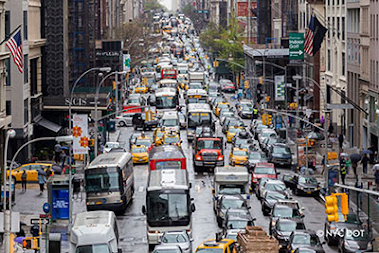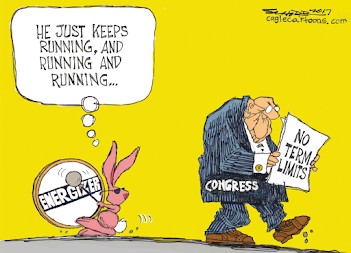The Car Dependency Problem
By Liam Sadlier
Car dependency is a term that reflects the favoring of cars over other means of transportation, be that public transportation or pedestrian and bike travel. While car dependency is common throughout many parts of the world, in America, cars dominate the culture and way of life of most of its residents. As of 2020, over 90% of U.S. households have access to at least one vehicle (bankrate.com, 2022). This is not always out of desire, as unless one lives in a major city or large town, cars become a necessity for everyday life. Additionally, even in these cities and large towns, the streets are often packed with cars from commuters and visitors. Car dependency leads to a lack of freedom, and the removal of this dependency will mitigate the negative consequences of cars while providing a variety of benefits for Americans.
Prior to the introduction of the private automobile, electric streetcars dominated the public transit of many major American cities. These streetcars remained well used from the 1880s into the 1920s, providing residents transport throughout, and sometimes outside, the city. The decline of the streetcar resulted from a variety of factors, such as corruption within the industry, a lack of profitability, and governmental policies that favored infrastructure for private vehicles (encyclopedia.com, 2019). The economic boom following World War II allowed for many citizens to own private vehicles and move further away from cities into the suburbs, thus extensive public transportation fell into the rearview mirror of a now car dependent America.
While cars can provide a variety of benefits to those who own them, the problems that cars contribute to tend to outweigh these benefits. First, cars play a large role in America’s greenhouse gas emissions, the emissions that facilitate anthropogenic climate change. According to the United States Environmental Protection Agency (EPA), transportation generates 27% of the United States’ greenhouse gas emissions. Of this portion, 57% comes from light duty vehicles, in other words, private vehicles such as SUVs, sedans, and pickup trucks (epa.gov, 2022). Car dependency also results in wasted time for drivers and passengers. Traffic caused by the congestion of private vehicles costs Americans approximately 3.7 billion hours annually (Saeidizand, Fransen, & Boussauw, 2022). Lastly, the price of cars, paired with the ever-changing cost of gasoline, insurance, and maintenance puts poor communities in a difficult financial situation. On one hand, people living in suburbs and rural areas often need a car to get to work, the grocery store, the pharmacy, or any other essential business. On the other hand, the costs associated with a vehicle weighs heavily on those who can barely afford them but need them to travel. With polluted airs, wasted time, and strained wallets, one might wonder about a more efficient, sustainable solution to transit than private vehicles and car dependency. Fortunately, a viable solution presents itself, and its origins predate cars themselves.
As mentioned previously, American cities boasted robust public transit systems before they fell to the rapidly expanding automotive industry. A reinvestment into public transit systems, along with the development of walkable, people-centered communities, would revitalize American cities and towns. The United States Department of Transportation (DOT) provides a list of many benefits provided by public transit (transportation.gov, 2015). First, the DOT notes that public transportation travel results in less than half the rate of deaths than private automobile travel. Additionally, it is mentioned that public transportation produces fewer
greenhouse gas emissions and uses less fuel than private automobiles. Health benefits also arise from the implementation of public transit and walkable city planning. This is shown in a study the DOT references, which found an increase in physical activity among public transit passengers. Public transportation also provides essential, safe travel for the elderly and those with physical disabilities. Finally, public transit offers a more affordable alternative to private vehicles, allowing those in desperate financial situations to save money that would otherwise go towards the costs associated with a personal vehicle (transportation.gov, 2015).
While public transit provides a vast array of benefits to residents, walkable infrastructure also becomes necessary in the attempt to lessen the hold that car dependency has on Americans. Single-family zoning laws greatly restrict the freedom of urban planners to create walkable cities. According to Emily Badger and Quoctrung Bui of the New York Times, “It is illegal on 75 percent of the residential land in many American cities to build anything other than a detached single-family home” (Badger & Bui, 2019). Mixed-use zoning allows developers to more effectively and efficiently use land to create walkable communities. Instead of large areas dedicated to detached homes, local small businesses could become an integral part of every community, and it would be easy for residents to walk to these businesses.
To conclude, car dependency restricts the freedom of Americans. Its consequences extend to negative environmental impacts, wasted time, and the burdening of America’s working class. An investment into public transportation and walkable communities would reduce the negative impact of these consequences and provide other benefits such as reduced greenhouse gas emissions, healthier residents, and more equitable access to transportation. With President Biden’s Bipartisan Infrastructure Law passed, a better future for American transit lies in sight.
While a step in the right direction, it is necessary to continue the momentum of investing in people and communities instead of private automobile companies.




Comments
Post a Comment